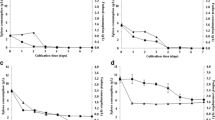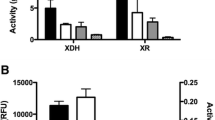Summary
A novel yeast strain, NCIM 3574, isolated from a decaying wood produced up to 570 IU ml−1 of xylanolytic enzymes when grown on medium containing 4% xylan. The yeast strain also produced xylanase activity (40–50 IU ml−1) in the presence of soluble carbon sources like xylose or arabinose. No xylanase activity was detected when the organism was grown on glucose. The crude xylanase preparation showed no activity towards cellulolytic substrates but low levels of β-xylosidase (0.1 IU ml−1) and α-l-arabinofuranosidase (0.05 IU ml−1) were detected. The temperature and pH optima for the crude xylanase preparation were 55°C and 4.5 respectively. The crude xylanase produced mainly xylose from xylan within 5 min. Prolonged hydrolysis of xylan produced xylobiose and arabinose, in addition to xylose, as the end products. The presence of arabinose as one of the end products in xylan hydrolysate could be due to the low levels of arabinofuranosidase enzyme present in the crude fermentation broth.
Similar content being viewed by others
References
Bastawde, K.B. 1992. Cellulolytic enzymes of a thermotolerantAspergillus terreus strain and their action on cellulosic substrates. World J. Microbiol. Biotechnol. 8: 45–49.
Bastawde, K.B. 1992. Xylan structure, microbial xylanases and their mode of action. World J. Microbiol. Biotechnol. 8: 353–368.
Bastawde, K.B. and D.V. Gokhale. 1991. A process for the preparation of extracellular arabinose liberating exoxylanase from a pure yeast strain. India Patent Application no. 1119/DEL/91 dated 18.11.91.
Berghem, L.E.R. and L.G. Pettersson. 1973. The mechanism of enzymic cellulose degradation: purification of a cellulolytic enzyme fromTrichoderma viride, active on highly ordered cellulose. Eur. J. Biochem. 37: 21–30.
Biely, P., Z. Kratky, A. Kochova-Kratochilova and S. Bauer. 1978. Xylan degrading activity in yeast: growth on xylose, xylan and hemicelluloses. Folia Microbiol. 27: 366–371.
Biely, P., M. Vrsanka and Z. Kratky. 1980. Xylan degrading enzymes of the yeastCryptococcus albidus. Identification and cellular localization. Eur. J. Biochem. 108: 313–321.
Dekker, R.F.H. 1985. Degradation of the hemicellulose. In: Biosynthesis of Wood Components (Higuchi, T., ed.), pp. 505–533, Academic Press, Tokyo.
Fischer, E.H. and E.A. Stein. 1961. Amylase from human saliva. Biochem Preparations 8: 27–33.
Johnson, K.G., M.C. Silva, C.R. Mackenzie, H. Schneider and J.D. Fontana. 1989. Microbial degradation of hemicellulosic materials. Appl. Biochem. Biotechnol. 21: 245–257.
Leathers, T.D. 1986. Color variants ofAureobasidium pullulans overproducing xylanases with extremely high specific activity. Appl. Environ. Microbiol. 52: 1026–1030.
Leathers, T.D. 1989. Purification and properties of xylanase fromAureobasidium. J. Ind. Microbiol. 4: 341–348.
Leathers, T.D., R.M. Detroy and R.J. Bothast. 1986. Induction and glucose repression of xylanase from a color variant strain ofAureobasidium pullulans. Biotechnol. Lett. 8: 867–872.
Leathers, T.D., C.P. Kurtzman and R.M. Detroy. 1984. Overproduction and regulation of xylanase inAureobasidium pullulans andCryptococcus albidus. Biotechnol. Bioeng. Symp. 14: 225–240.
Lee, H., R.J.B. To, R.K. Latta, P. Biely and H. Schneider. 1987. Some properties of extracellular acetylxylan esterase produced by the yeastRhodotorula muciloginosa. Appl. Environ. Microbiol. 53: 2831–2834.
Linko, M. 1989. Enzymes in the forefront of food and feed industries. Food Biotechnol. 3: 1–9.
Mackenzie, C.R. and R.E. Williams. 1984. Detection of cellulase and xylanase activity in isoelectric focussed gels using agar substrate gels supported on plastic film. Can. J. Microbiol. 30: 1522–1525.
Pontecorvo, G., J.A. Roper, L.M. Hemmons, K.D. McDonald and A.W.J. Bufton. 1953. Genetics ofAspergillus nidulans. Adv. Genet. 5: 142–238.
Stevens, B.J. and J. Payne. 1977. Cellulase and xylanase production by yeasts of the genusTrichosporon. J. Gen. Microbiol. 100: 381–393.
Thompson, N.S.C. 1983. Hemicellulose as a biomass resource. In: Wood and Agricultural Residues. Research on Use for Feed, Fuel and Chemicals (Soltes, E.J., ed.), pp. 101–119, Academic Press, New York.
Trevelyen, W.E., D.P. Procter and J.S. Harrison. 1950. Detection of sugars on paper chromatograms. Nature 166: 444–445.
Wong, K.K.Y., L.U.L. Tan and J.N. Saddler. 1988. Multiplicity of β-1,4-xylanase in microorganisms: functions and applications. Microbiol. Rev. 52: 305–317.
Yasui, T., B.T. Nguyen and K. Nakanishi. 1984. Inducers for xylanase production byCryptococcus flavus. J. Ferment. Technol. 62: 353–359.
Author information
Authors and Affiliations
Rights and permissions
About this article
Cite this article
Bastawde, K.B., Puntambekar, U.S. & Gokhale, D.V. Optimization of cellulase-free xylanase production by a novel yeast strain. Journal of Industrial Microbiology 13, 220–224 (1994). https://doi.org/10.1007/BF01569752
Received:
Accepted:
Issue Date:
DOI: https://doi.org/10.1007/BF01569752




